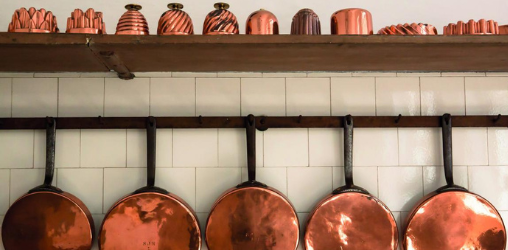Cooper in cookware
Copper was the first metal used for the manufacture of cookware largely due to its malleability. In the roman era, it was mainly obtained from cyprus, which gives its name to the metal (from latin: cuprum) and evolving into the name we use today “copper”.
Copper is one of the few noble metals that can be found in nature used without prior treatment. Thus it was the first metal that was used to manufacture kitchen utensils. It is the heaviest, the most expensive and one of the best conductors of heat.
Unfortunately, it is also very reactive in air. It oxidizes easily, forming a grey-green patina that can easily become very toxic and easily contaminate food.
Due to the problems of toxicity and the high cost of both maintenance and purchase, the use of cooking vessels manufactured from copper has been reduced to a minimal level, even though we can occasionally find them in the world of patisserie or decoration.

In order to prevent or delay the oxidation process, copper vessels are usually coated on the inside with a thin layer of a much less reactive metal, namely tin. However, tin is very delicate and, with wear, the layer becomes thinner and ends up being completely worn away at some points. It also melts at 232°C, usually lower than the temperature of the flame or hob. When the vessel is full it is unlikely to reach this temperature as the food would burn first, but with an empty container it is very easy for the tin liner to melt as a result of the high temperature. Therefore, it is recommended that you never place empty, coated copper containers in direct contact with the heat source. Therefore, it is recommended that you never place empty, coated copper containers in direct contact with the heat source.
However, because of its high thermal conductivity, copper is the most suitable material when very fast temperature variations are required, in particular rapid cooling in order to stop cooking. Typically, this would apply when heating sugar.

Did you know that?
To clean the outside of uncoated copper items, you should make up a solution of 100g of
water with 20g of white vinegar and a tablespoon of baking soda This solution can be used to clean the outside, as long as it hasn’t been finished with some type of varnish If this is the case, the manufacturer’s instructions should be followed
the manufacturer’s instructions
Cooper in cookware
MATERIAL: very high weight. Moldable, but very oxidizable.
THERMAL CONDUCTIVITY: Even heat distribution throughout the receptacle.
USE: Suitable for gas and electric cookers. Ideal for cooking where precise temperature control is required.
MAINTENANCE AND HYGIENE: Cleaning with neutral soaps and non-abrasive sponges. Not suitable for dishwashers. Where food has stuck to the vessel, leave to soak in a mixture of white-wine vinegar and lemon.






Leave a reply